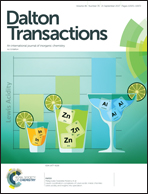A new strategy for inducing dipole moments in charge-transfer complexes: introduction of asymmetry into axially ligated iron phthalocyanines†
Abstract
Introduction of asymmetry into charge-transfer complexes composed of axially ligated iron phthalocyanines was achieved. In the obtained crystals of TPP[FeIII(Pc)(CN)Cl]2, TPP[FeIII(Pc)(CN)Br]2, and TPP[FeIII(Pc)BrCl]2 (TPP = tetraphenylphosphonium and Pc = phthalocyanine), the axial positions of the iron atoms were occupied by 50/50 ratios of the ligands CN/Cl, CN/Br, and Br/Cl, respectively. The crystal structures of the obtained CT complexes were isostructural to those composed of the symmetric analogues of the type [FeIII(Pc)L2] (L = CN, Cl or Br); the [FeIII(Pc)LL′] units formed regular one-dimensional chains along the c-axis following the symmetry of the P42/n space group. Despite forming similar regular chains to the symmetric systems, the electrical resistivities and activation energies were enhanced in the obtained CT complexes compared to those in symmetric systems, indicating that the charge-ordered states were stabilised by the introduction of asymmetry. More specifically, the dielectric relaxation behaviour of the inhomogeneous disordered TPP[FeIII(Pc)(CN)Cl]2 probably suggests that a dipole moment was induced in this material.



 Please wait while we load your content...
Please wait while we load your content...